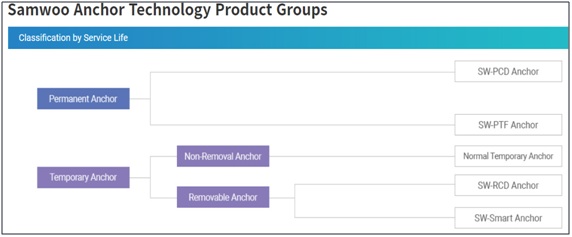SAMWOO TECHNOLOGYCo., Ltd. has been endeavoring to be the leading company in the ground anchor Manufacturer industry for over 28 years. It is the first company to obtain ISO 9001 certification in the field of ground anchor design, production, and additional services in Korea.
A ground anchor is a tension element used to apply a restraining force to a structure by anchoring the distal end of the anchor in the ground. Ground anchors have been used worldwide for over fifty years to restrain structures in intimate contact with the ground surface to provide stability to these structures and control deformations caused by active ground pressures. Earth anchoring systems
Comparison of Features of SAMWOO Anchor by Types
✔Load Concentrative TensionType Anchor: When stress is applied to tension-type anchors, load transfer occurs to bond length through adhesion of steel strand and grout. Due to load concentration, the parts of the tension-type anchor attached with steel strand and grout become unzipped and this leads to crack and load reduction. In addition, the tension-type anchor has the weakness of progressive de-bonding and time-dependent load reduction (creep) occurrence when the friction of the load concentration zone exceeds the extreme skin friction of the target ground.
✔Load Concentrative Compression Type Anchor: Compression type anchors consist of an un-bonded polyethylene (PE)-coated steel strand which transfers the jacking force/load directly to a structural element located at the distal end of the anchor. Unlike the tension-type anchors, the grout body for compression-type anchors is loaded in compression which is capable of securing many higher loads. However, due to the concentrative design of these anchors, the use of high-strength grout is frequently required to secure the jacking forces at the distal end. Also, it is often difficult to secure concentrative anchorage force in weak soils.
✔Load Distributive Tension / Compression Type Anchor:High stresses from tension and conventional compression type anchors transfer concentrated loads to the soil and grout body which can become overstressed resulting in failure. Therefore, load distributive compression type anchors have been developed and are being used, which uniformly distribute the anchor load to the grout body and soil along the theoretical length of the bond zone. In addition, the grout strength requirements are reduced as well as applied eccentricity. As a result, high loads can be achieved even in normal soil conditions. Recently, load distributive tension-type anchors have been developed which are capable of securing stable loads in even relatively weak soils such as clay and silts.



